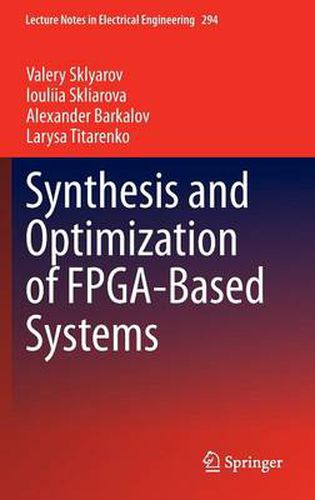Readings Newsletter
Become a Readings Member to make your shopping experience even easier.
Sign in or sign up for free!
You’re not far away from qualifying for FREE standard shipping within Australia
You’ve qualified for FREE standard shipping within Australia
The cart is loading…






This title is printed to order. This book may have been self-published. If so, we cannot guarantee the quality of the content. In the main most books will have gone through the editing process however some may not. We therefore suggest that you be aware of this before ordering this book. If in doubt check either the author or publisher’s details as we are unable to accept any returns unless they are faulty. Please contact us if you have any questions.
The book is composed of two parts. The first part introduces the concepts of the design of digital systems using contemporary field-programmable gate arrays (FPGAs). Various design techniques are discussed and illustrated by examples. The operation and effectiveness of these techniques is demonstrated through experiments that use relatively cheap prototyping boards that are widely available. The book begins with easily understandable introductory sections, continues with commonly used digital circuits, and then gradually extends to more advanced topics. The advanced topics include novel techniques where parallelism is applied extensively. These techniques involve not only core reconfigurable logical elements, but also use embedded blocks such as memories and digital signal processing slices and interactions with general-purpose and application-specific computing systems. Fully synthesizable specifications are provided in a hardware-description language (VHDL) and are ready to be tested and incorporated in engineering designs. A number of practical applications are discussed from areas such as data processing and vector-based computations (e.g. Hamming weight counters/comparators). The second part of the book covers the more theoretical aspects of finite state machine synthesis with the main objective of reducing basic FPGA resources, minimizing delays and achieving greater optimization of circuits and systems.
$9.00 standard shipping within Australia
FREE standard shipping within Australia for orders over $100.00
Express & International shipping calculated at checkout
This title is printed to order. This book may have been self-published. If so, we cannot guarantee the quality of the content. In the main most books will have gone through the editing process however some may not. We therefore suggest that you be aware of this before ordering this book. If in doubt check either the author or publisher’s details as we are unable to accept any returns unless they are faulty. Please contact us if you have any questions.
The book is composed of two parts. The first part introduces the concepts of the design of digital systems using contemporary field-programmable gate arrays (FPGAs). Various design techniques are discussed and illustrated by examples. The operation and effectiveness of these techniques is demonstrated through experiments that use relatively cheap prototyping boards that are widely available. The book begins with easily understandable introductory sections, continues with commonly used digital circuits, and then gradually extends to more advanced topics. The advanced topics include novel techniques where parallelism is applied extensively. These techniques involve not only core reconfigurable logical elements, but also use embedded blocks such as memories and digital signal processing slices and interactions with general-purpose and application-specific computing systems. Fully synthesizable specifications are provided in a hardware-description language (VHDL) and are ready to be tested and incorporated in engineering designs. A number of practical applications are discussed from areas such as data processing and vector-based computations (e.g. Hamming weight counters/comparators). The second part of the book covers the more theoretical aspects of finite state machine synthesis with the main objective of reducing basic FPGA resources, minimizing delays and achieving greater optimization of circuits and systems.